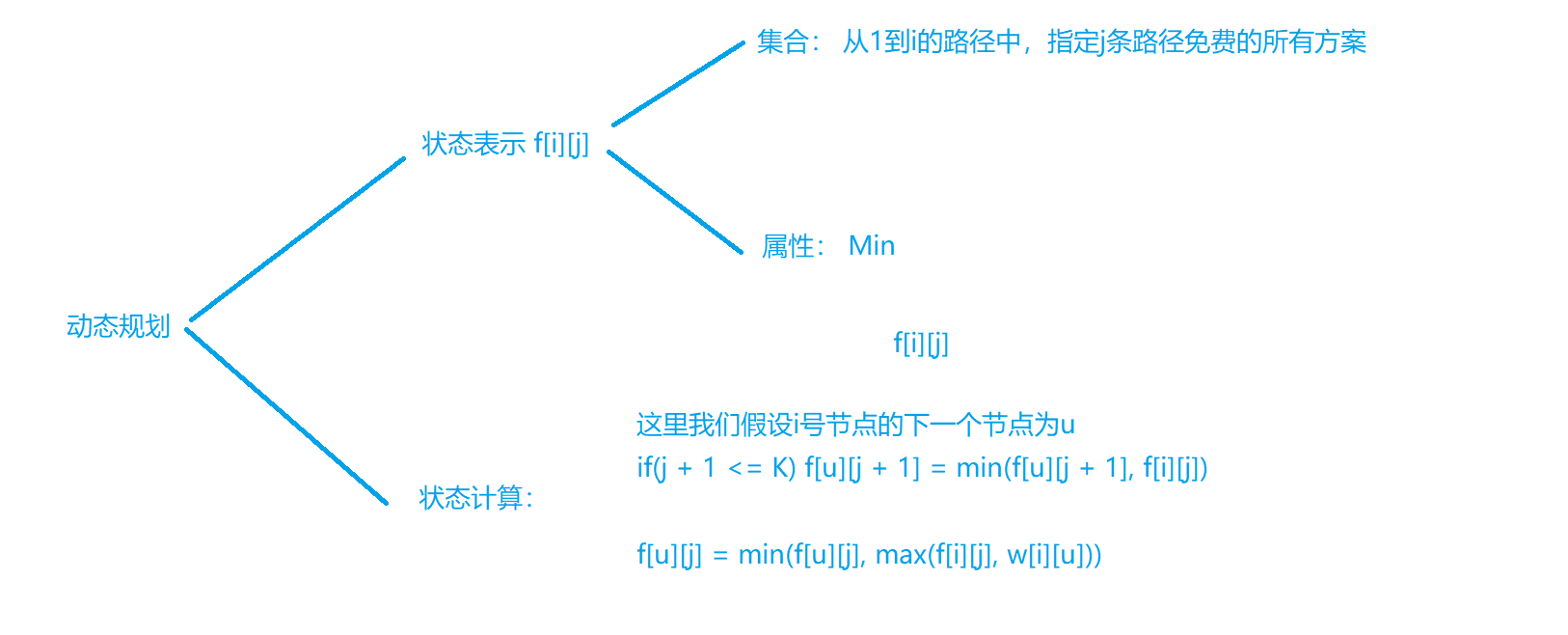题目描述
在郊区有 $N$ 座通信基站,$P$ 条 双向 电缆,第 $i$ 条电缆连接基站Ai和Bi。
特别地,$1$ 号基站是通信公司的总站,$N$ 号基站位于一座农场中。
现在,农场主希望对通信线路进行升级,其中升级第 $i$ 条电缆需要花费Li。
电话公司正在举行优惠活动。
农产主可以指定一条从 $1$ 号基站到 $N$ 号基站的路径,并指定路径上不超过$K $条电缆,由电话公司免费提供升级服务。
农场主只需要支付在该路径上剩余的电缆中,升级价格最贵的那条电缆的花费即可。
求至少用多少钱可以完成升级。
输入格式
第1行:三个整数$N$,$P$,$K$。
第$2..P+1$行:第 $i+1$ 行包含三个整数$Ai$,$Bi$,$Li$。
输出格式
包含一个整数表示最少花费。
若$1$号基站与$N$号基站之间不存在路径,则输出”-1”。
数据范围
$0≤K<N≤1000,$
$1≤P≤10000,$
$1≤Li≤1000000$
样例
输入样例:
5 7 1
1 2 5
3 1 4
2 4 8
3 2 3
5 2 9
3 4 7
4 5 6
输出样例:
4
算法1
(二分 + 最短路)
题目中的要求是农场主可以指定不超过k个电缆的消费为0,首先,这道题可以使用二分,因为题目中问的是使得最大的值最小,所以我们可以二分最终的消费,然后对于每一次二分的消费x,根据要求,可以判断图中是否存在一条路径,这条路径上边权大于x的边小于等于k,如果满足,则说明x这个点是可以取的。
对于上面的具有二分性,这里给一个简单的证明:
如下图
假设x这点是最终的最优解,也就是图中存在一条路径,这条路径上大于x的边权个数小于等于k,那么对于x右边的所有值都是可以满足的,而x左边的值如果满足,那么x就不是最优解了,产生矛盾,所以这道题的解具有二段性,可以使用二分来解。
时间复杂度分析:
这道题使用双端队列BFS的时间复杂度为$O(log_{2}^{L} * (n + m))$,n为点数,m为边数
需要注意的是,二分的左边界可以取0,因为如果路径总个数小于等于k,那耗费为0,右边界取1e6 + 1,因为题目中存在无解的情况,所以只要二分到了1e6 + 1,该题就是无解的。
由于边权只有0和1,所以这里可以使用双端队列BFS,也可以使用Dijkstra算法。
时间复杂度
这道题使用双端队列BFS的时间复杂度为$O(log_{2}^{L} * (n + m))$,n为点数,m为边数
参考文献
算法提高课
java 代码
import java.io.*;
import java.util.*;
class Main{
static int N = 1010, M = 20010, max = (int)1e6 + 1, INF = 0x3f3f3f3f;
static int[] h = new int[N];
static int[] dist = new int[N];
static boolean[] st = new boolean[N];
static int[] e = new int[M];
static int[] ne = new int[M];
static int[] w = new int[M];
static int n, p, k, idx;
static void add(int a, int b, int c){
e[idx] = b;
w[idx] = c;
ne[idx] = h[a];
h[a] = idx ++;
}
static boolean check(int x){
Arrays.fill(dist, INF);
Arrays.fill(st, false);
dist[1] = 0;
LinkedList<Integer> q = new LinkedList<Integer>();
q.add(1);
while(!q.isEmpty()) {
int t = q.removeFirst();
if(t == n) return dist[n] <= k;
if(st[t]) continue;
st[t] = true;
for(int i=h[t]; i!=-1; i=ne[i]) {
int j = e[i];
int c = w[i] > x ? 1 : 0;
if(dist[j] > dist[t] + c) {
dist[j] = dist[t] + c;
if(c == 0) q.addFirst(j);
else q.addLast(j);
}
}
}
return false;
}
public static void main(String[] args) throws IOException{
BufferedReader in = new BufferedReader(new InputStreamReader(System.in));
Arrays.fill(h, -1);
String[] arr = in.readLine().split(" ");
n = Integer.parseInt(arr[0]);
p = Integer.parseInt(arr[1]);
k = Integer.parseInt(arr[2]);
for(int i=0; i<p; i++){
String[] cur = in.readLine().split(" ");
int a = Integer.parseInt(cur[0]);
int b = Integer.parseInt(cur[1]);
int c = Integer.parseInt(cur[2]);
add(a, b, c);
add(b, a, c);
}
int l = 0; int r = max;
while(l < r){
int mid = l + r >> 1;
if(check(mid)) r = mid;
else l = mid + 1;
}
if(r == max) System.out.println(-1);
else System.out.println(l);
}
}
算法2
(分层图/拆点)
可以使用动态规划的思路来解决:

但是由于该动态规划的状态转移方程不具有拓扑结构,故这里需要使用分层图/拆点,使用最短路的求解方式实现动态规划的状态转移,最后枚举f[n][i],i = [0, k],找到一个最小值就是最终的结果,如果最小值都为正无穷,则说明无解,输出-1。
时间复杂度
这种方法的时间复杂度为$O(m * log_{2}^{n})$
参考文献
算法提高课
Java 代码
import java.io.*;
import java.util.*;
class Node implements Comparable<Node>{
int t, k, dist;
public Node(int t, int k, int dist){
this.t = t;
this.k = k;
this.dist = dist;
}
@Override
public int compareTo(Node o){
return dist - o.dist;
}
}
class Main{
static int N = 1010, M = 20010, INF = 0x3f3f3f3f;
static int[] h = new int[N];
static int[] e = new int[M];
static int[] ne = new int[M];
static int[] w = new int[M];
static int[][] dist = new int[N][N];
static boolean[][] st = new boolean[N][N];
static int idx, n, m, Lim;
static void add(int a, int b, int c){
e[idx] = b;
w[idx] = c;
ne[idx] = h[a];
h[a] = idx ++;
}
static void Dijkstra() {
for(int i=1; i<=n; i++) Arrays.fill(dist[i], INF);
dist[1][0] = 0;
PriorityQueue<Node> q = new PriorityQueue<Node>();
q.add(new Node(1, 0, 0));
while(!q.isEmpty()) {
Node cur = q.poll();
int u = cur.t;
int k = cur.k;
int distance = cur.dist;
if(st[u][k]) continue;
st[u][k] = true;
for(int i=h[u]; i!=-1; i=ne[i]) {
int j = e[i];
if(k + 1 <= Lim && dist[j][k+1] > distance) {
dist[j][k+1] = distance;
q.add(new Node(j, k+1, dist[j][k+1]));
}
if(dist[j][k] > Math.max(distance, w[i])) {
dist[j][k] = Math.max(distance, w[i]);
q.add(new Node(j, k, dist[j][k]));
}
}
}
}
public static void main(String[] args) throws IOException{
BufferedReader in = new BufferedReader(new InputStreamReader(System.in));
Arrays.fill(h, -1);
String[] cur = in.readLine().split(" ");
n = Integer.parseInt(cur[0]);
m = Integer.parseInt(cur[1]);
Lim = Integer.parseInt(cur[2]);
while(m -- > 0){
String[] arr = in.readLine().split(" ");
int a = Integer.parseInt(arr[0]);
int b = Integer.parseInt(arr[1]);
int c = Integer.parseInt(arr[2]);
add(a, b, c); add(b, a, c);
}
Dijkstra();
int res = INF;
for(int i=0; i<=Lim; i++) res = Math.min(res, dist[n][i]);
if(res == INF) System.out.println(-1);
else System.out.println(res);
}
}


对于方法一, 我们的目的是
图中存在一条路径,这条路径上大于x的边权个数<=k. 但是双端队列或者Dijkstra都是用来求最短路的, 它们实际上是求图中存在一条**最短路**路径,这条路径上大于x的边权个数<=k. 两者为什么能等价呢? 我能理解如果在最短路里能找到这样的x, 那么显然整个图一定是存在这个路径的; 但是反过来, 即使是最短路里没有找到这样的x, 能一定等价说明图例不存在这样的路径(即使这个路径也不是最短路) 吗 ? 这点一直想不通. 请教一下大佬! 谢谢!